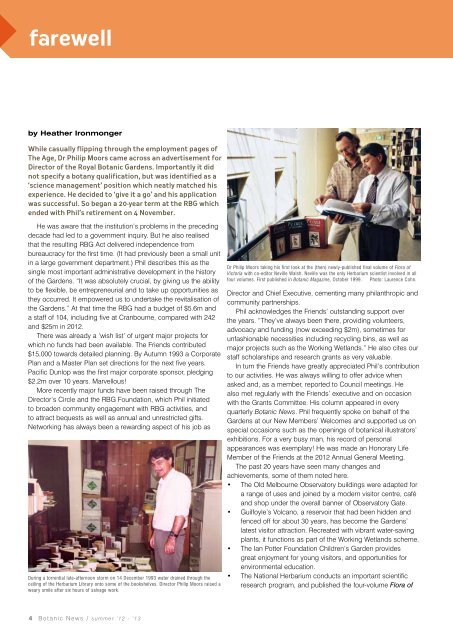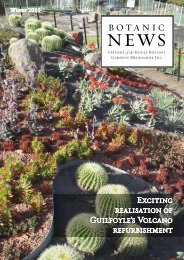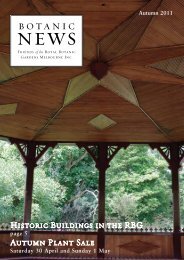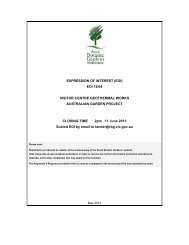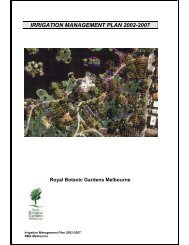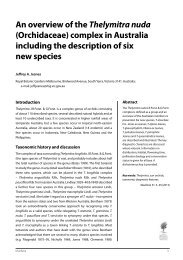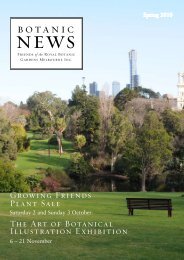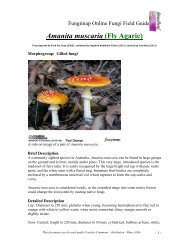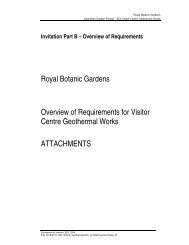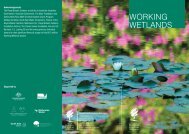Summer 2012-13(PDF - 1.32 mb) - Royal Botanic Gardens Melbourne
Summer 2012-13(PDF - 1.32 mb) - Royal Botanic Gardens Melbourne
Summer 2012-13(PDF - 1.32 mb) - Royal Botanic Gardens Melbourne
Create successful ePaper yourself
Turn your PDF publications into a flip-book with our unique Google optimized e-Paper software.
farewell from the president<br />
by Heather Ironmonger<br />
While casually flipping through the employment pages of<br />
The Age, Dr Philip Moors came across an advertisement for<br />
Director of the <strong>Royal</strong> <strong>Botanic</strong> <strong>Gardens</strong>. Importantly it did<br />
not specify a botany qualification, but was identified as a<br />
‘science management’ position which neatly matched his<br />
experience. He decided to ‘give it a go’ and his application<br />
was successful. So began a 20-year term at the RBG which<br />
ended with Phil’s retirement on 4 Nove<strong>mb</strong>er.<br />
He was aware that the institution’s problems in the preceding<br />
decade had led to a government inquiry. But he also realised<br />
that the resulting RBG Act delivered independence from<br />
bureaucracy for the first time. (It had previously been a small unit<br />
in a large government department.) Phil describes this as the<br />
single most important administrative development in the history<br />
of the <strong>Gardens</strong>. “It was absolutely crucial, by giving us the ability<br />
to be flexible, be entrepreneurial and to take up opportunities as<br />
they occurred. It empowered us to undertake the revitalisation of<br />
the <strong>Gardens</strong>.” At that time the RBG had a budget of $5.6m and<br />
a staff of 104, including five at Cranbourne, compared with 242<br />
and $25m in <strong>2012</strong>.<br />
There was already a ‘wish list’ of urgent major projects for<br />
which no funds had been available. The Friends contributed<br />
$15,000 towards detailed planning. By Autumn 1993 a Corporate<br />
Plan and a Master Plan set directions for the next five years.<br />
Pacific Dunlop was the first major corporate sponsor, pledging<br />
$2.2m over 10 years. Marvellous!<br />
More recently major funds have been raised through The<br />
Director’s Circle and the RBG Foundation, which Phil initiated<br />
to broaden community engagement with RBG activities, and<br />
to attract bequests as well as annual and unrestricted gifts.<br />
Networking has always been a rewarding aspect of his job as<br />
During a torrential late-afternoon storm on 14 Dece<strong>mb</strong>er 1993 water drained through the<br />
ceiling of the Herbarium Library onto some of the bookshelves. Director Philip Moors raised a<br />
weary smile after six hours of salvage work.<br />
Dr Philip Moors taking his first look at the (then) newly-published final volume of Flora of<br />
Victoria with co-editor Neville Walsh. Neville was the only Herbarium scientist involved in all<br />
four volumes. First published in <strong>Botanic</strong> Magazine, October 1999. Photo: Laurence Cohn.<br />
Director and Chief Executive, cementing many philanthropic and<br />
community partnerships.<br />
Phil acknowledges the Friends’ outstanding support over<br />
the years. “They’ve always been there, providing volunteers,<br />
advocacy and funding (now exceeding $2m), sometimes for<br />
unfashionable necessities including recycling bins, as well as<br />
major projects such as the Working Wetlands.” He also cites our<br />
staff scholarships and research grants as very valuable.<br />
In turn the Friends have greatly appreciated Phil’s contribution<br />
to our activities. He was always willing to offer advice when<br />
asked and, as a me<strong>mb</strong>er, reported to Council meetings. He<br />
also met regularly with the Friends’ executive and on occasion<br />
with the Grants Committee. His column appeared in every<br />
quarterly <strong>Botanic</strong> News. Phil frequently spoke on behalf of the<br />
<strong>Gardens</strong> at our New Me<strong>mb</strong>ers’ Welcomes and supported us on<br />
special occasions such as the openings of botanical illustrators’<br />
exhibitions. For a very busy man, his record of personal<br />
appearances was exemplary! He was made an Honorary Life<br />
Me<strong>mb</strong>er of the Friends at the <strong>2012</strong> Annual General Meeting.<br />
The past 20 years have seen many changes and<br />
achievements, some of them noted here.<br />
• The Old <strong>Melbourne</strong> Observatory buildings were adapted for<br />
a range of uses and joined by a modern visitor centre, café<br />
and shop under the overall banner of Observatory Gate.<br />
• Guilfoyle’s Volcano, a reservoir that had been hidden and<br />
fenced off for about 30 years, has become the <strong>Gardens</strong>’<br />
latest visitor attraction. Recreated with vibrant water-saving<br />
plants, it functions as part of the Working Wetlands scheme.<br />
• The Ian Potter Foundation Children’s Garden provides<br />
great enjoyment for young visitors, and opportunities for<br />
environmental education.<br />
• The National Herbarium conducts an important scientific<br />
research program, and published the four-volume Flora of<br />
4 <strong>Botanic</strong> News / summer ‘12 - ‘<strong>13</strong>


